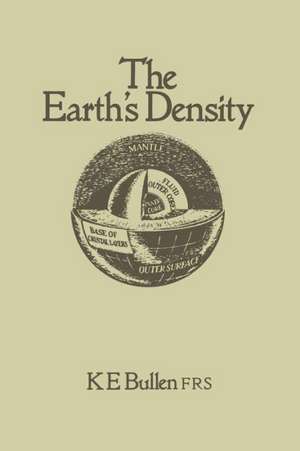The Earth’s Density
Autor K. E. Bullenen Limba Engleză Paperback – 19 oct 2011
Preț: 396.40 lei
Nou
Puncte Express: 595
Preț estimativ în valută:
75.85€ • 79.04$ • 62.80£
75.85€ • 79.04$ • 62.80£
Carte tipărită la comandă
Livrare economică 03-17 aprilie
Preluare comenzi: 021 569.72.76
Specificații
ISBN-13: 9789400957022
ISBN-10: 9400957025
Pagini: 440
Ilustrații: XIV, 420 p.
Dimensiuni: 155 x 235 x 23 mm
Greutate: 0.61 kg
Ediția:Softcover reprint of the original 1st ed. 1975
Editura: SPRINGER NETHERLANDS
Colecția Springer
Locul publicării:Dordrecht, Netherlands
ISBN-10: 9400957025
Pagini: 440
Ilustrații: XIV, 420 p.
Dimensiuni: 155 x 235 x 23 mm
Greutate: 0.61 kg
Ediția:Softcover reprint of the original 1st ed. 1975
Editura: SPRINGER NETHERLANDS
Colecția Springer
Locul publicării:Dordrecht, Netherlands
Public țintă
ResearchCuprins
1. Noted ancient investigations.- 1.1 Size of the Earth.- 1.2 Contributions of Newton and contemporaries.- 1.3 The period after Newton.- References.- 2. Determination of the mean density of the Earth.- 2.1 Bouguer’s experiments in Peru.- 2.2 The Schiehallion experiment.- 2.3 Other pendulum and plumb-line experiments.- 2.4 The Michell-Cavendish experiment.- 2.5 Other small-scale experiments.- References.- 3. Spherical harmonics.- 3.1 Solutions of Laplace’s equation.- 3.2 Legendre polynomials.- 3.3 Integrals of products of spherical harmonics.- 3.4 Tesseral harmonics.- 3.5 Expansions iQ spherical harmonics.- 3.6 Spherical harmOnICs and Earth oscillation theory.- References.- Theory of the Earth’s gravitational attraction.- 4.1 General theorems on gravitational attraction.- 4.2 Attractions due to some particular mass distributions.- 4.3 MacCullagh’s formula.- 4.4 Representation of the Earth’s surface.- 4.5 Attraction due to spheroidal Earth model.- References.- 5. The figure and moment of inertia of the Earth.- 5.1 The geopotential function.- 5.2 Forms of surfaces of equal density inside rotating Earth model.- 5.3 Relations involving ?a and h.- 5.4 Clairaut’s equation on the internal variation of ?.- 5.5 Estimation of the moment of inertia of the Earth.- 5.6 Numerical results on the hydrostatic theory.- 5.7 Use of artificial satellites.- 5.8 International reference systems.- 5.9 Ellipticities of internal surfaces of constant densitys.- References.- 6. Early models of the Earth’s density variation.- 6.1 Earth models.- 6.2 Clairaut’s equation and the density problem.- 6.3 The Legendre-Laplace density law.- 6.4 Background theory in density determination.- 6.5 Other early model density laws.- 6.6 Numerical results for early models.- 6.7 Some furthernineteenth century results.- 6.8 Early evidence on the Earth’s rigidity.- 6.9 Early twentieth century models.- 6.9 Early twentieth century models.- 7. Representation of elasticity in the Ear.- 7.1 Stress.- 7.2 Strain and rotation.- 7.3 Model stress-strain relations.- 7.4 Stress-strain relations for the Earth.- 7.5 Interpretation of coefficients in perfect elasticity.- 7.6 Strength of a material.- 7.7 The terms ‘fluid’ and ‘solid’.- 7.8 Pressure and finite strain.- 7.9 Thermodynamic considerations.- References.- 8. Seismic wave transmission.- 8.1 Earthquakes and other sources of seismic waves.- 8.2 Equations of motion of seismic disturbances.- 8.3 Bodily seismic waves.- 8.4 Scalar and vector potentials.- 8.5 Surface seismic waves.- 8.6 Refraction and reflexion of bodily seismic waves.- References.- First approximation to seismic P and S distributions in the Earth.- 9.1 Seismic rays.- 9.2 Effect of the Earth's ellipticity on seismic travel times.- 9.3 Normal and abnormal seismic velocity variation.- 9.4 Bodily seismic phases.- 9.5 Evolution of travel-time tables.- 9.6 Derivation of P and S velocity distributions in the Earth.- References.- 10. Earth models of type A.- 10.1 Introductory theory of density variation in the Earth.- 10.2 Historical background on the Earth’s internal layering.- 10.3 The regions A, B, C, D, E, F and G.- 10.4 Density near the Earth’s surface.- 10.5 Early evidence on inhomogeneity insitle the upper mantle.- 10.6 Minimum central density.- 10.7 Earth models of type A.- 10.8 Corrections for temperature and inhomogeneity.- Critique of A-type models.- References.- 11. Evidence on compressibility in the Earth.- 11.1 Compression in the Earth.- 11.2 Variation of incompressibility in homogeneous regions.- 11. 3 Some further implications offinite-strain theory.- 11.4 Compressibility-pressure hypothesis.- 11.5 Theory for inhomogeneous regions.- 11.6 Degrees of inhomogeneity in particular regions of the Earth.- 11.7 Solidity of the inner core.- 11.8 Earth models of type B.- References.- 12. Some second approximations.- 12.1 P and S velocities in the mantle.- 12.2 Structure of the outer core.- 12.3 Structure of the inner core.- 12.4 Radius of the Earth’s core.- 12.5 The Earth’s central density.- 12.6 Further evidence bearing on rigidity in lower core.- 12.7 Improved B-type models.- References.- 13. Evidence from seismic surface waves.- 13.1 Underlying principles in applying surface-wave data.- 13.2 More complex model structures.- 13.3 Direct observation of phase velocities.- 13.4 Allowance for Earth’s curvature and gravity.- 13.5 Evidence on crustal structure.- 13.6 Evidence on mantle structure.- 13.7 Surface waves and density variation.- 13.8 Further remarks.- References.- 14. Evidence from free Earth oscillations.- 14.1 Free oscillations of a dynamical system.- 14.2 Approach to the theory of Earch oscillations.- 14.3 Equations of motion of an oscillating Earth model.- 14.4 Solving the equations of motion.- 14.5 Observational data.- 14.6 Early inferences from free Earth oscillation data.- 14.7 The model HB1.- 14.8 Other models using free Earth osciIlation data.- 14.9 Oscillation evidence on solidity of inner core.- References.- 15. Miscellaneous developments.- 15.1 Equations of state, and related equations, for the Earth’s interior.- 15.2 Some miscellaneous Earth models.- 15.3 Monte Carlo techniques.- 15.4 The general problem of ‘inverting’ observation data.- 15.5 Density and seismic wave amplitudes.- 15.6 Implications of wave-scattering investigations.- 15.7 Deviations from sphericalsymmetry.- 15.8 Changes in gravitational constant.- References.- 16. Optimum and standard Earth models.- 16.1 General requirements of Earth models.- 16.2 Consequence of non-uniqueness.- 16.3 Approaches to the optimum model problem.- 16.4 Progress towards an optimum Earth model.- 16.5 The problem of a standard Earth model.- References.- 17. Application to other planets and the Moon.- 17.1 Planetary observational data.- 17.2 Assumptions on the Earth’s internal composition.- 17.3 Earth, Venus, Mars.- 17.4 Mercury.- 17.5 Moon.- 17.6 Jupiter and Saturn.- 17.7 Uranus and Neptune.- 17.8 Pluto.- 17.9 Further remarks.- References.




